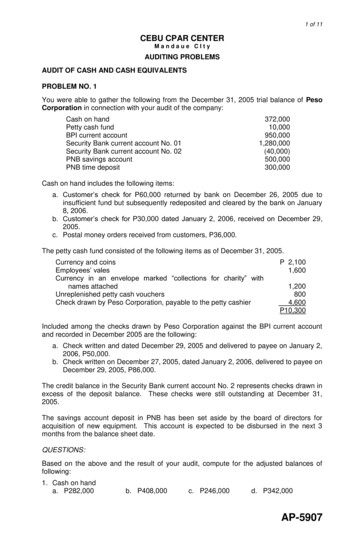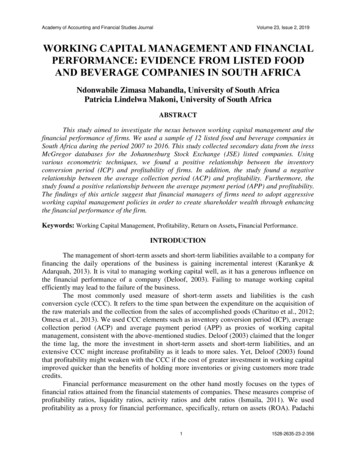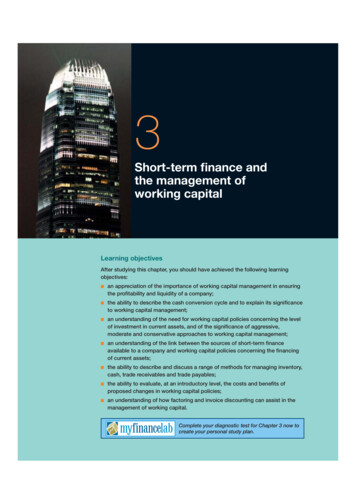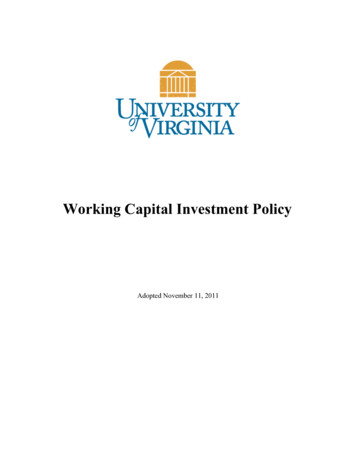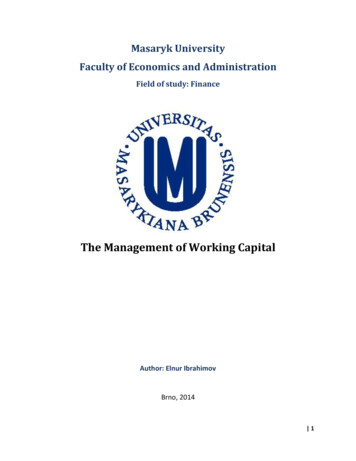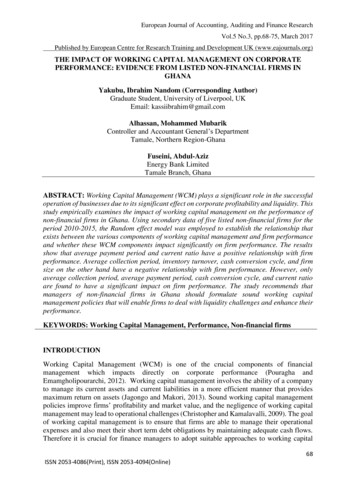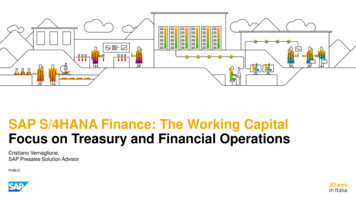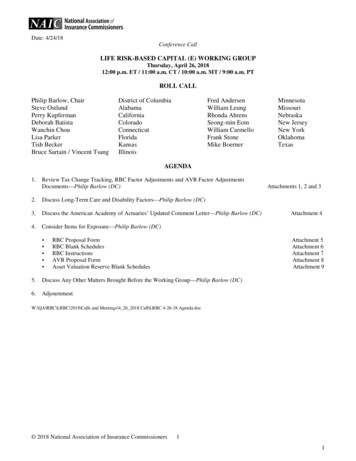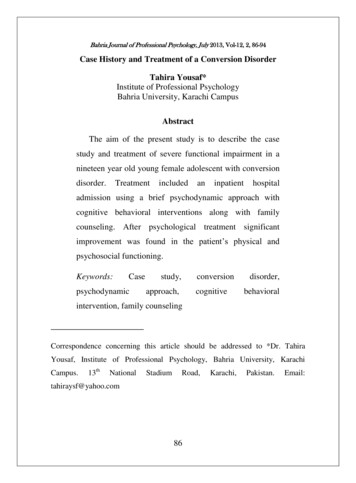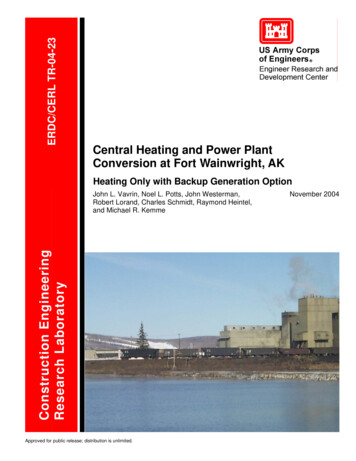
Transcription
Working Capital andCash Conversion CycleJarrod Goentzelgoentzel@mit.eduJarrod GoentzelBalance sheet Snapshot of the firm’s value Assets– Current: cash, marketable securities, accounts receivable, inventories– Long-term: property, plant, equipment (less accumulated depreciation)– Intangible: patents, goodwill “growth assets” current yearfuture yearsLiabilities– Current: accounts payable, notes payable, – Long-term: notes, bonds, deferred income taxes, Shareholders’ equity (a.k.a. net worth)– Stock: preferred, common– Retained earningsJarrod Goentzel1
Income statement Describes performance between snapshotsExplains why retained earnings has changed over timeRevenue or Sales (net of markdowns)Cost of goods sold (COGS)GROSS INCOMEOperating expenses (a.k.a. Selling, general & administrative, or SG&A)OPERATING INCOMEEBITDADepreciation & amortizationEBITOPERATING INCOMEInterest expenseOther non-operating expenses/incomeIncome taxesExtraordinary itemsNET INCOMEJarrod GoentzelWorking capital Working capital is required to – operate the business– serve the customers– deal with some variation in the timing of cash flows Working capital is a basic measure of both a company'sefficiency and its short-term financial health– Too much: may indicate inefficient use of resources, low return– Not enough: may indicate potential cash flow problems, high risk Working capital analysis considers the – Magnitude of each component– Timing of the cash flowsJarrod Goentzel2
Working capital Working Capital Current Assets - Current Liabilities– Cash conversion cycle: Accounts Receivable, Inventory,Accounts Payable– Other: Cash, short term investments, short term debt Working capital requirements are an investment– Firm finances A/R and inventory– Firm receives financing from suppliers in the form of A/P– WC Requirement A/R Inventory – A/P OtherJarrod GoentzelWorking capital requirements exerciseTickerFiscal YearSales (Net)Cost of Goods 89,845227,030170,329Inventories - TotalReceivables - Total (Net)Accounts ing Capital RequiredWorking Capital Investment ta Source: S&P Capital IQJarrod Goentzel3
Working capital Working Capital Current Assets - Current Liabilities– Cash conversion cycle: Accounts Receivable, Inventory,Accounts Payable– Other: Cash, short term investments, short term debt Working capital requirements are an investment– WC Requirement A/R Inventory – A/P Other In order to reduce working capital requirements– Collect payment as quickly as possible– Keep stock levels as low as possible– Delay paying suppliers as long as possibleJarrod GoentzelSC Finance Practices & Impact on WCWorkingCapitalPracticePotential TradeoffExtended payment terms from suppliersXDiscount for early payment by customersFinance raw materials & WIP for small suppliersXXHigher unit costLower revenueAssured supply3PL finances Vendor Managed Inventory (VMI)XHigher unit costInventory / production loan from financialinstitutionXAdditional financecostDiscount for early payment to suppliersXFactoring confirmed receivables/Letters of CreditExtended payment terms for customersXXUtilize partner credit relationship for betterfinancing termsJarrod GoentzelLower unit costLower revenueMarket shareXMay require higherservice levelAdapted from Jim Rice4
CCC: CASH CONVERSION CYCLECCC: Cash Conversion Cycle(or Cash-to-Cash Cycle) The terms Cash Conversion Cycle and Cash-toCash Cycle are used interchangeably Focuses on A/R, A/P, and inventory It is the amount of time (in days) that a companytakes to sell inventory, collect receivables andpay accounts payable The combined cycle indicates how much cash istied up in the company’s operations(procurement, production, sales, etc.)Jarrod Goentzel5
Days of Inventory Outstanding (DIO)DIO Average Inventory/One Day COGS Average Inventory/(COGS/365)– A financial measure indicating how long it takes acompany to turn its inventory (including raw materials,WIP, and finished goods) into sales– Inventory is recorded at cost, so COGS is used– DIO is also known as Days Sales in Inventory (DSI)– It is the inverse of Inventory Turnover (e.g. DIO of 91 daysis the same as Inventory Turnover of 4)– In general, lower DIO is better, provided the company isnot missing out on sales due to lack of inventoryJarrod GoentzelDays of Payables Outstanding (DPO)DPO Average Accounts Payable/One Day COGS Average Accounts Payable/(COGS/365)– A financial measure indicating how long a company istakes to pay its suppliers– Accounts Payables are recorded at cost of thematerials, so COGS is used– In general, higher DPO is better, provided thecompany is not damaging supplier relationships orperformance by delaying paymentJarrod Goentzel6
Days of Sales Outstanding (DSO)DSO Average Accounts Receivable/One Day Sales Average Accounts Receivable/(Sales/365)– A financial measure indicating how long a company takesto collect the cash after making a sale– Accounts Receivable are credit sales to customers, soTotal (credit) Sales is used Note that if the business uses cash, then one should separateout credit sales because cash sales are not ‘outstanding’– In general, lower DSO is better, provided the company isnot missing out on sales due to lack of customer creditJarrod GoentzelCash Conversion Cycle (CCC) DIO - Days Inventory Outstanding DSO - Days Sales Outstanding DPO - Days Purchases OutstandingRaw material or finished goodtransferred ownershipProduct sold tocustomerDIODSOTimeDPOCash Conversion CyclePay the supplierCollect moneyJarrod Goentzel7
CCC can be negativeexample: Dell in 1990sRaw material or finished goodarrived at DellProduct sold tocustomerDSODIOCash Conversion Cycleis negativeDPOCollectmoneyPay thesupplierJarrod GoentzelCCC Exercise: Automotive IndustryTickerFiscal YearSales (Net)Cost of Goods SoldInventories - TotalReceivables - Total (Net)Accounts 73,35220,095Avg InventoryAvg A/RAvg 6.764.031.138.8121.544.6115.8Data Source: S&P Capital IQJarrod Goentzel8
CCC: Automotive IndustryTickerFiscal YearSales (Net)Cost of Goods 88,333Inventories - TotalReceivables - Total (Net)Accounts PayableAvg InventoryAvg A/RAvg 845.196.3Data Source: S&P Capital IQJarrod GoentzelWorking Capital SurveySource: 2015 US Working Capital Survey. The Hackett /uswcsurvey/Jarrod Goentzel9
Working Capital SurveySource: 2015 US Working Capital Survey. The Hackett /uswcsurvey/Jarrod GoentzelWorking Capital SurveySource: 2015 US Working Capital Survey. The Hackett /uswcsurvey/Jarrod Goentzel10
DPO may not as critical for financialperformanceSource: Kroes and Manikas. (2014) “Cash flow management and manufacturing firm financial performance: Alongitudinal perspective.” Int. Journal of Production Economics, 148, 37-50. doi:10.1016/j.ijpe.2013.11.008Jarrod Goentzel11
Working Capital Required 85 403 13,231 16,719 Working Capital Investment 2014 318 3,488. 4 Working capital Working Capital Current Assets - Current Liabilities – Cash conversion cycle: Accounts Receivable, Inventory, Accounts Payable – Other: Cash, short term investments, short term debt Working capital requirements are an investment – WC Requirement A/R Inventory – A/P .File Size: 464KBPage Count: 11
